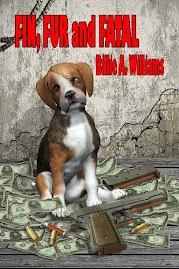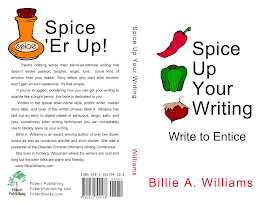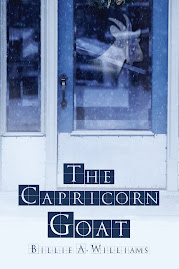A New Soap Opera for Authors
Between belonging to two critique groups, being edited by different publishing houses and reading information on blogs, I feel more confused than ever. It seems that rules change from house-to-house, and while the lines blur, I’m very clear on the following traps we authors fall into while writing. I just wonder why some people refuse to crawl out after they’ve tripped up. I keep reading the same mistakes over and over so I’m offering a few helpful hints that I’ve garnered from friends with much more experience than yours truly. I trust that their awesome grasp on what NOT to do when writing that winning novel will help me get famous someday. *lol*.
I’m going to address a few areas in no particular order:
1. ACTION/REACTION Sequence
The sequence makes sense. Before someone can react, something has to happen first. What may seem simple can be demonstrated with the following examples:
John jumped up and screamed when the ghost appeared from the closet. Or A ghost appeared from the closet, and John jumped up and screamed.
Sally bumped her head when the car hit a curb. OR The car hit a curb and Sally bumped her head. Both make sense, but the rule is: Action first, Reaction second.
The ghost appearing is the ACTION, and I believe John’s REACTION is apparent.
Sally probably wouldn’t bump her head unless the car hit a curb. Make sense?
2. ‘THAT’ bad habit
When I write, and I notice others do the same, I tend to stick in ‘that’ where not necessary. I almost did it when I wrote the first sentence. Out of habit, I wanted to put “I notice THAT others do the same. A rejection I received a few years back noted I used ‘that’ far too frequently, so now I’ve become accustomed to thinking before I type it. I normally would have typed the preceding sentence thusly: A recent rejection THAT I received noted THAT I used ‘that” far too frequently, so now THAT I’ve become accustomed to thinking… I think THAT you get the picture…oops. I think you get the picture.
3. BACK STORY
Almost every story we write requires some back story (facts leading up to current), but the secret is peppering it throughout so that we don’t bury the reader with it. Novels are supposed to unfold as they’re read—happen in the moment and draw the reader into the action. If you spend paragraph upon paragraph TELLING what has already happened rather than SHOWING what is happening now, you’ve most likely lost the reader’s interest. Give enough detail to bring the reader up to speed but don’t drown them in facts that may not impact the story at all. It’s an acquired talent and one I’m working hard on.
The same goes for describing the scene. The reader doesn’t need to know the location of every tree on the property and how many birds nest in them. Better yet, paint a mental image of the tree shading the heroine’s window and the light filtering through the leaves. I recently read a drafted story in which the author fully-described everything in the heroine’s kitchen, down to the knives in the drawer. I tried to explain that you might mention the counter as the heroine moved past and picked up a knife from the drawer, but three paragraphs describing everything in the room soon grew tedious and overdone.
4. RUE
Resist the Urge to Explain = RUE. A good writer enables the reader to determine emotions from the text. Rather than TELL the reader that your heroine is sad, use descriptive sentences to reflect it. Let the reader assign the emotion. Which would you prefer?
It was Cindy’s birthday and she felt sad.
Or
The red circle on the calendar mocked Cindy—her birthday. But today seemed like any other day. As she sifted the mail, rifling through unwanted catalogs and advertisements, she hoped for one single personally-addressed envelope. She found none.
After writing, editing and learning, I'm so much more aware of unnecessary information we add to our stories when our dialogue should show the feeling and eliminate the need to explain what the reader should feel or see.
ANOTHER EXAMPLE:
Excited, Sasha entered the room. She felt tense and nervous at the same time. She needed water to soothe her thirst.
Could be: Sasha burst into the room. (Entered versus burst – using an action verb to show her excitement). Her heart raced, yet her jaw tensed. (showing her tenseness and nervousness). She smacked her lips, hoping for saliva to combat the cottony feel in her mouth. (showing her thirst).
Okay...so I'm not Nora Roberts...I wrote this on the spur of the moment. :) I think you get the message.
5. NAMES
If you have an exchange going on between two people and it is clear to reader, there is no need to continually use the characters name in the dialogue. One must assume the reader is intelligent enough to determine who is speaking to whom with a minimal of hints and tags. Wouldn’t you find this a tad tedious? The concept is taken from something I recently proofread for one publisher:
Jane and Fred sat next to the fire, enjoying their wine. Fred turned to her, with the flames reflecting in his eyes. "Jane, I'm having a wonderful time. Thank you for inviting me."
"Me too, Fred. I'm so glad you came."
"Jane, would you like me to refill your glass?"
"No thank you, Fred. I'm fine. I get giddy if I drink too much."
The same applies for starting every sentence with ‘she/he’. She heard the bell chime can be The bell chimed. She saw the sunset become an artist’s pallet of colors can be The sunset became an artist’s pallet of colors. He or she doesn’t have to identify with everything. Words are better spent describing action to your readers. In the character’s POV, the reader will assume who is doing the feeling, looking, sensing, etc.
I notice this is a trap into which most new writers fall. (See, I didn’t end with a preposition)
6. TENSES (Past, Present, Past imperfect…blah, blah, blah.)
I'm still trying to acclimate to reading things written with 'could see', 'could hear' 'could speak', 'had been missing'. Although I realize it's a style, I've had it beaten into me that 'saw', 'heard', 'spoke', and 'missed' make the story unfold in the moment, and for me are preferred.
Consider, 'she could see his face, even in the dim light. The only sound she could hear was crickets outside the window. If only he could speak the words she longed for. She had been missing him far more than she expected.'
Now consider...She saw his face, even in the dim light. The only sound she heard was the crickets’ chirping outside the window. If only he spoke the words she longed for. She'd missed him far more than she expected.
Okay...CORNY! Still, I prefer this style when at all possible. I realize that dialogue can be in past tense, but I want to feel my stories happeningNOW .
We all write so differently. Each of us have a style or flair innately our own. I’m willing to make some changes and concessions during editing, but one thing I will fight for…keeping my own voice. Everyone should. It’s what makes us unique and helps us stand apart from the crowd. The hard thing is trying to convince your editor of that. *lol*
What things have you learned during your editing process, and was this at all helpful? I hope so.
1. ACTION/REACTION Sequence
The sequence makes sense. Before someone can react, something has to happen first. What may seem simple can be demonstrated with the following examples:
John jumped up and screamed when the ghost appeared from the closet. Or A ghost appeared from the closet, and John jumped up and screamed.
Sally bumped her head when the car hit a curb. OR The car hit a curb and Sally bumped her head. Both make sense, but the rule is: Action first, Reaction second.
The ghost appearing is the ACTION, and I believe John’s REACTION is apparent.
Sally probably wouldn’t bump her head unless the car hit a curb. Make sense?
2. ‘THAT’ bad habit
When I write, and I notice others do the same, I tend to stick in ‘that’ where not necessary. I almost did it when I wrote the first sentence. Out of habit, I wanted to put “I notice THAT others do the same. A rejection I received a few years back noted I used ‘that’ far too frequently, so now I’ve become accustomed to thinking before I type it. I normally would have typed the preceding sentence thusly: A recent rejection THAT I received noted THAT I used ‘that” far too frequently, so now THAT I’ve become accustomed to thinking… I think THAT you get the picture…oops. I think you get the picture.
3. BACK STORY
Almost every story we write requires some back story (facts leading up to current), but the secret is peppering it throughout so that we don’t bury the reader with it. Novels are supposed to unfold as they’re read—happen in the moment and draw the reader into the action. If you spend paragraph upon paragraph TELLING what has already happened rather than SHOWING what is happening now, you’ve most likely lost the reader’s interest. Give enough detail to bring the reader up to speed but don’t drown them in facts that may not impact the story at all. It’s an acquired talent and one I’m working hard on.
The same goes for describing the scene. The reader doesn’t need to know the location of every tree on the property and how many birds nest in them. Better yet, paint a mental image of the tree shading the heroine’s window and the light filtering through the leaves. I recently read a drafted story in which the author fully-described everything in the heroine’s kitchen, down to the knives in the drawer. I tried to explain that you might mention the counter as the heroine moved past and picked up a knife from the drawer, but three paragraphs describing everything in the room soon grew tedious and overdone.
4. RUE
Resist the Urge to Explain = RUE. A good writer enables the reader to determine emotions from the text. Rather than TELL the reader that your heroine is sad, use descriptive sentences to reflect it. Let the reader assign the emotion. Which would you prefer?
It was Cindy’s birthday and she felt sad.
Or
The red circle on the calendar mocked Cindy—her birthday. But today seemed like any other day. As she sifted the mail, rifling through unwanted catalogs and advertisements, she hoped for one single personally-addressed envelope. She found none.
After writing, editing and learning, I'm so much more aware of unnecessary information we add to our stories when our dialogue should show the feeling and eliminate the need to explain what the reader should feel or see.
ANOTHER EXAMPLE:
Excited, Sasha entered the room. She felt tense and nervous at the same time. She needed water to soothe her thirst.
Could be: Sasha burst into the room. (Entered versus burst – using an action verb to show her excitement). Her heart raced, yet her jaw tensed. (showing her tenseness and nervousness). She smacked her lips, hoping for saliva to combat the cottony feel in her mouth. (showing her thirst).
Okay...so I'm not Nora Roberts...I wrote this on the spur of the moment. :) I think you get the message.
5. NAMES
If you have an exchange going on between two people and it is clear to reader, there is no need to continually use the characters name in the dialogue. One must assume the reader is intelligent enough to determine who is speaking to whom with a minimal of hints and tags. Wouldn’t you find this a tad tedious? The concept is taken from something I recently proofread for one publisher:
Jane and Fred sat next to the fire, enjoying their wine. Fred turned to her, with the flames reflecting in his eyes. "Jane, I'm having a wonderful time. Thank you for inviting me."
"Me too, Fred. I'm so glad you came."
"Jane, would you like me to refill your glass?"
"No thank you, Fred. I'm fine. I get giddy if I drink too much."
The same applies for starting every sentence with ‘she/he’. She heard the bell chime can be The bell chimed. She saw the sunset become an artist’s pallet of colors can be The sunset became an artist’s pallet of colors. He or she doesn’t have to identify with everything. Words are better spent describing action to your readers. In the character’s POV, the reader will assume who is doing the feeling, looking, sensing, etc.
I notice this is a trap into which most new writers fall. (See, I didn’t end with a preposition)
6. TENSES (Past, Present, Past imperfect…blah, blah, blah.)
I'm still trying to acclimate to reading things written with 'could see', 'could hear' 'could speak', 'had been missing'. Although I realize it's a style, I've had it beaten into me that 'saw', 'heard', 'spoke', and 'missed' make the story unfold in the moment, and for me are preferred.
Consider, 'she could see his face, even in the dim light. The only sound she could hear was crickets outside the window. If only he could speak the words she longed for. She had been missing him far more than she expected.'
Now consider...She saw his face, even in the dim light. The only sound she heard was the crickets’ chirping outside the window. If only he spoke the words she longed for. She'd missed him far more than she expected.
Okay...CORNY! Still, I prefer this style when at all possible. I realize that dialogue can be in past tense, but I want to feel my stories happening
We all write so differently. Each of us have a style or flair innately our own. I’m willing to make some changes and concessions during editing, but one thing I will fight for…keeping my own voice. Everyone should. It’s what makes us unique and helps us stand apart from the crowd. The hard thing is trying to convince your editor of that. *lol*
What things have you learned during your editing process, and was this at all helpful? I hope so.
Don’t forget to stop by my website at http://www.gingersimpson.com and please come visit my blog, “Dishin’ It Out,” http://mizging.blogspot.com
Ya’ll come.
Ginger











